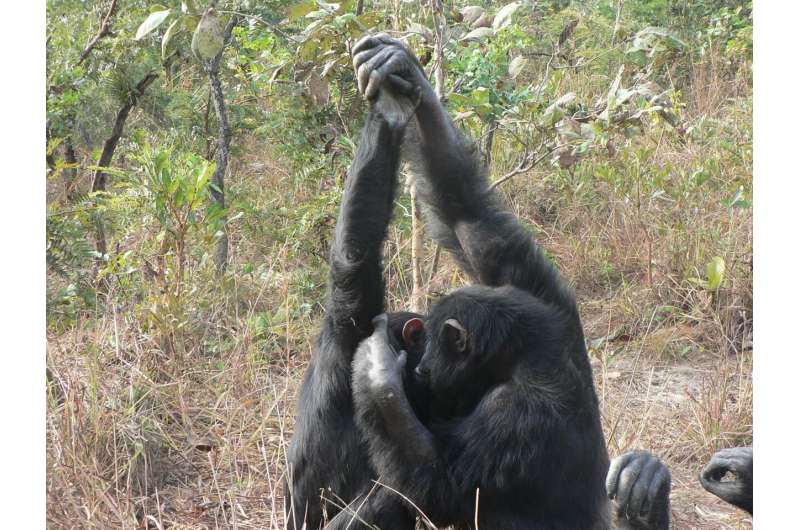February 16, 2023 report
This article has been reviewed according to Science X's editorial process and policies. Editors have highlighted the following attributes while ensuring the content's credibility:
fact-checked
peer-reviewed publication
trusted source
proofread
Grooming handclasp in chimpanzees found to be culturally transmitted

A pair of animal behaviorists, one from Utrecht University, in the Netherlands, the other from the University of London, has found that grooming handclasps in chimpanzees is a behavior transmitted between generations culturally.
In their paper published in the journal Science Advances, Edwin J. C. van Leeuwen and William Hoppitt describe a decade-long observational study they conducted of chimpanzees living in the Chimfunshi Wildlife Orphanage Trust in Zambia.
Prior research efforts and anecdotal evidence have shown that chimpanzees engage in a wide variety of social activities, from reciprocal grooming to sharing meals. They also engage in what has come to be known as grooming handclasps—though not all chimps do it the same way.
In this new effort, C. van Leeuwen and Hoppitt wondered about the nature of the activity because it did not appear to be tied to anything related to survival. Instead, it appeared to be purely social in nature. They also noted that the execution of handclasps appeared to differ between different groups of chimps.
So the researchers began recording instances of grooming handclasps as part of observational record-keeping. Eventually, they analyzed the data in their records for the years 2007 to 2019, looking for patterns in such activities, hoping to learn more about how its origins.
The researchers found that that the activity was not genetic—young chimps had no idea that hand clasping was in their future. Instead, the activity was learned, first from their mothers and then from other older peers. As the chimps learned, the mechanics of the handclasp changed for each of them, evolving over time until settling on a final form. In studying how the final form developed, the researchers found it was most profoundly impacted by younger chimps watching and mimicking other chimps in their group that held the most prestige or who were most dominant.
The researchers were not able to discern exactly why chimps execute grooming handclasps or why they persist, but suggest they are likely tied to attempts by younger chimps to increase their own status. They report that they saw no signs of discouragement among the chimps; those that opted to create their own handclasps were not punished nor were there any agitations as a result.
More information: Edwin J. C. van Leeuwen et al, Biased cultural transmission of a social custom in chimpanzees, Science Advances (2023). DOI: 10.1126/sciadv.ade5675
Journal information: Science Advances
© 2023 Science X Network




















